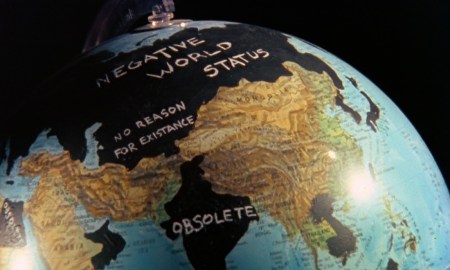366 Weird Movies may earn commissions from purchases made through product links.


DIRECTED BY: Giuseppe Andrews
FEATURING: Bill Tyree, Giuseppe Andrews
PLOT: Intertwined stories of a number of absurd characters including a French dwarf who has rough sex with a teddy bear and a perpetually naked old man who has sex with an imaginary woman.

COMMENTS: “WARNING: This film contains senior citizen nudity and dead pigs.”
Now, geriatric nudity is no big thing (although when the octogenarian attempts to holds pork rinds between his buttcheeks, you may disagree). That dead pig, though… we’ll get to it.
Period Piece is a series of absurdist sketches that rarely rise to the level of jokes, and never to the level of insights. They aren’t planned out, they are just passing spurts from the brain of director Giuseppe Andrews, whose mind is not filled with classical allusions like a Jean Cocteau or scathing anti-bourgeois fantasies like a Luis Buñuel, but mostly with dirty words, bodily function imagery, and trailer park culture. The result is arrested development surrealism, like something made by Harmony Korine if he were a complete psychopath.
You get segments about two guys who siphon gas to get money to shoot heroin in a car wash. Two other guys mime eating each others’ farts (which they slice with a plastic knife and eat with a fork, in about the closest the film comes to eliciting a chuckle.) Stop-motion tater tots have sex in front of a shrine to Charles Manson. A guy eats raw hamburger. That kind of stuff. It’s shot in camcorder glare, and the editing is deliberately bad, as if a few “good” fifteen second takes were assembled to make a scene. Sometimes the same line repeats with slightly different inflection. It’s unpleasantly disorienting and visually unflattering, so Andrews does achieve the Americana nightmare feel he’s going for. And just so you won’t be fooled into thinking you’re watching something with socially redeeming value, it opens with a bit where a guy wearing a fake mustache and speaking in a Pepe le Pew accent sodomizes a teddy bear with an industrial sized can of calm chowder. (The repeated, graphic molestation of the stuffed sex slave is an ongoing motif.) Also, a lot of people shoot themselves in ineffective mock suicides. It’s as disgusting as it sounds, and much of the time, it’s repetitive and tedious, but it’s capable of holding your interest—against your better judgement.
Although the climactic dead pig is explicitly named “Society,” the main target of the film’s ongoing and pervasive anger has been women and scarcity of sex. The teddy bear who “likes it rough” seems to stand in for woman as sexual objects. In one vignette a man threatens to kill a “whore” for cheating on him. A father and son leaf through the gynecological displays in well-worn stroke mags, and the son dreams of scoring someday. The naked old man delivers obscene, scatological monologues about vaginas. Although Andrews had a girlfriend at the time, and there is a woman in the cast, the whole project gives off the vibe of something conceived by poor white guys who’ve lost all hope of ever getting laid. Therefore, when Andrews’ attempt to top Pink Flamingos in the grossout department has the naked old man hack at the pig’s head with a hatchet while screaming insults at it, I was put more in mind of incels releasing sexual frustration than outsiders taking revenge against a system that has marginalized them.
The ending of the film disclaims that “no animals were hurt in the making of this film… they were already dead!” This is not strictly true. What about the human animals in the audience who had to watch it?
Troma proudly (?) picked up Period Piece (and some other Andrews movies) for distribution, despite the fact that it’s much darker (and even cheaper) than their usual fare. The DVD features an incongruously cheerful introduction by Lloyd Kaufman, a Kaufman interview with Andrews, trailers for other Andrews movies, an obscene misogynist poem written by Andrews and read bumblingly by Tyree, and the entire 70-minute bonus feature Jacuzzi Rooms— which is literally just an unscripted chronicle of four rednecks drinking heavily in a motel room. Fun stuff, for people for whom nothing matters.
WHAT THE CRITICS SAY:
(This movie was nominated for review by Tally Isham, who said “Not sure if I recommend seeing it, but it’s zero-budget weirdness.” Suggest a weird movie of your own here.)






